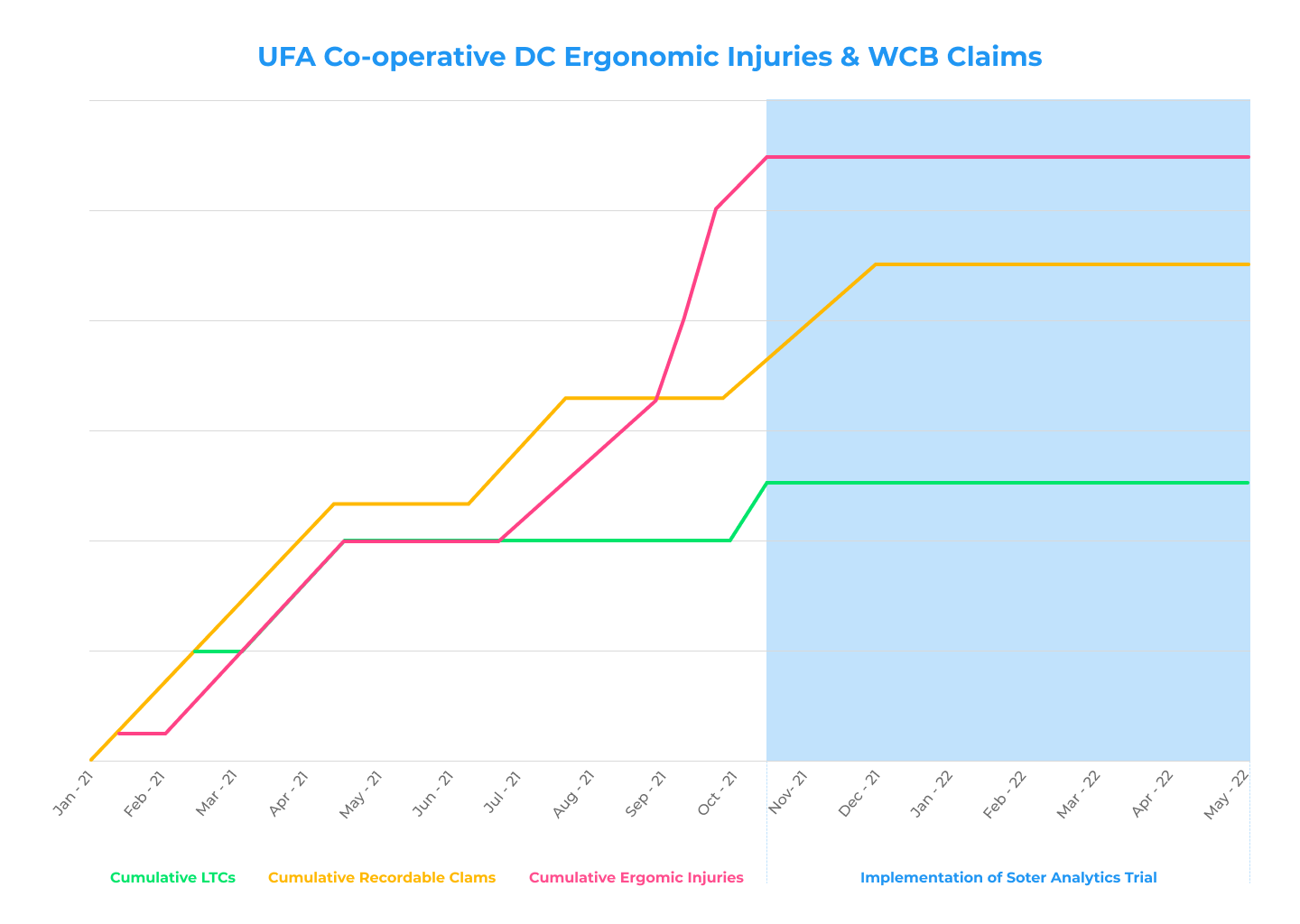'To change the complacency or change the behaviour, you have to work on changing habits'


Changing the movement behavior of workers in manual handling industries is key to reducing ergonomic injuries and claims.
Like most safety-conscious organizations, UFA Co-operative has consistently developed programs, looked at online/face-to-face training, strategized new safer practices, warm-up stretches; they've done it all. And although all these solutions have been beneficial, they found them to be short-term and unsustainable for the tenured or new workers.
Virginia MacKay, Incident Investigations Specialist & Senior H&S Advisor at UFA was challenged by their distribution center to come up with ways that could improve their claims history when it came to worker injuries. Specifically, at distribution, the claims typically were all about ergonomics, neck strains, back strains, and pulled shoulders.
When investigating the root cause of why these incidents happen, Virginia believed it is because of behaviour and says, “The behaviour and the complacency that's in place is where the problems stem, so for one to change the complacency or change the behaviour, you have to work on changing habits, re-elevate your existing program, and start thinking more proactively”.
After researching, UFA landed on the SoterCoach wearable technology solution offered by Soter Analytics.
The SoterCoach solution consisted of a small self-attaching clip-on device that is put either on the collar of a shirt for spine safety or connected to an arm strap for shoulder safety.
The sensors captured and alerted the workers via real-time audible and vibration feedback to any high-risk spine movements including, lumbar flexion, rotation, static postures, repetitive movements, and identified any high-intensity movements. The shoulder sensor detected the cumulative risk of arm elevations, repetition, static, overexertion and hazardous pushing and pulling of the shoulder.
All movement data was fed back to a personal companion app where workers could view their own results and follow micro-learning manual handling tutorials. An online management dashboard provides insight to where the risks are in the organization.
The behavioral change aspect of the sensors’ real-time biofeedback encouraged each worker to internally learn new and correct movement patterns, altering neuromuscular pathways and resulting in permanent movement change.
In November 2021 UFA rolled out the program on their pickers, sorters, and receivers at their DC and then due to the success, continued in their retail stores, yard areas, bulk petroleum and cardlock facilities.
The results
The results have easily justified the program with the longitudinal data showing that in 2021, before introducing Soter, the number of injuries and claims was consistently increasing. In Dec 2021 after Soter was implemented, there is a plateau in both claims and injuries resulting in:

86 per cent - Reduction in ergonomic injuries
67 per cent - Reduction in recordable workers' compensation claims (WCB)
43 per cent - Overall improvement in the number of spine hazards per hour
This equates to an 86 per cent reduction in total ergonomic injury costs* with an 11 x return on investment.
In addition to the direct cost savings for reduced WCB claims, UFA is also trending towards a reduction in their WCB premium, which is based on the last 3 years of claims.
Direct cost savings to UFA included: -
- Reduced hazardous movements → reduced biomechanical risk → reduced risk of injury
- Reduced the cost of manual handling training
- Reduced the requirement of observation/supervision of employees
- Profiling of hazardous tasks (task risk assessment) for their further elimination
- Reduction of claims costs & lost workdays
Priceless contributions include: -
- Reduction of claims costs & lost workdays
- Employee empowerment and autonomy
- Proactive insight into work done in the workplace
- Improved lifting techniques outside of work (24/7)
Worker feedback
Several workers indicated that when the device alerted them it made them stop and try to figure out what they were doing wrong.
“The Soter device I wore for the 10 days was great. In the beginning it would beep a lot but tapered off towards the end of the 10 days. I knew I was improving. It really did help me on how to bend properly and how to pick up things along with posture and twisting. It was good to see how well I did.”
“I truly believe that everyone should wear the Soter device because it helps you learn and understand how much pressure we put on our backs every day. The tutorials were a nice added touch with valuable information. I can now self-trigger myself when I am about to lift anything and it's all thanks to the device.”
“I found myself stopping when the device beeped to try to figure out what I was doing wrong.”
The data
The data collected by the devices was displayed on an online dashboard for management and was able to show UFA what site, departments, job roles and movements were at highest risk, and where to focus their attention.
They narrowed down which workers needed support by clear visuals on aggregated pages and individual reports.
Among other data, UFA found that in the DC, their pickers and sorters were the workers most at risk and poor bending, back twisting and repetition seemed to be the constant issue there. The data showed them exactly what area and which task was causing the high risk, so they were able to implement a tool to eliminate the risk and then obtain a comparison data report afterward.
“We all know that changing habits takes constant nagging reminders and it is easier said than done. The Soter devices and the SoterCoach tutorials offered a great way to help our workers be more aware of the hazardous movements they were making and to self-trigger right away when the device is alerting them”, says Virginia.
*based on North American average total injury costs (https://injuryfacts.nsc.org/work/costs/workers-compensation-costs/)
Toni-Louise Gianatti is Head of PR & Content for Soter Analytics, a global ergonomic technology company. With a 20-year background in coaching movement and posture awareness, Toni-Louise has spent the last 4 years researching the ground-level benefits, barriers, and outcomes of using wearables and AI for frontline worker health and highlighting data visibility and industry application for workforce efficiency and safety compliance.





